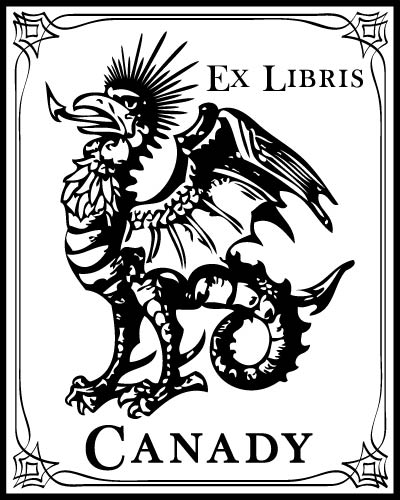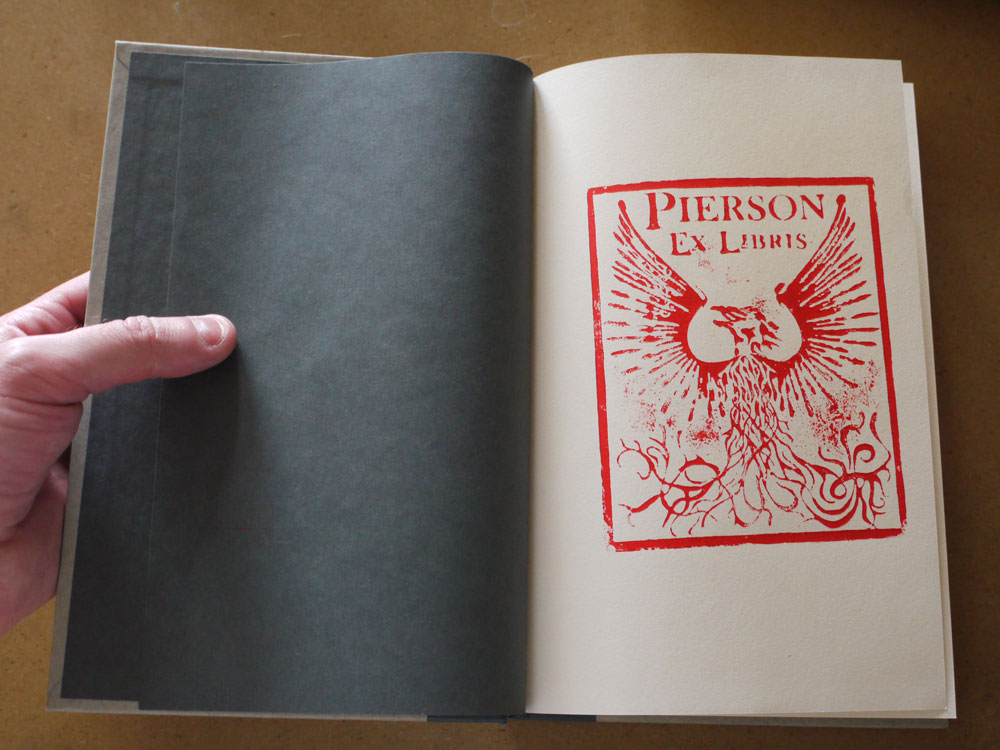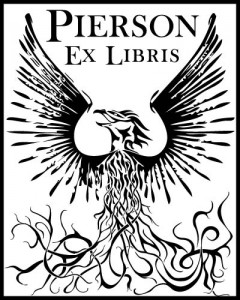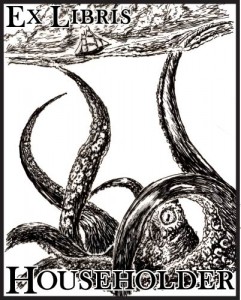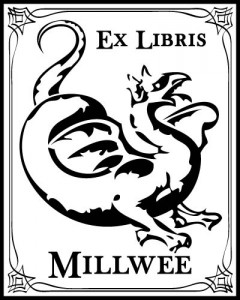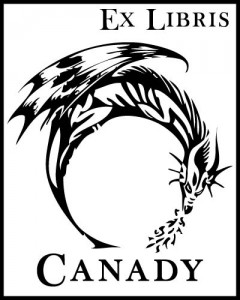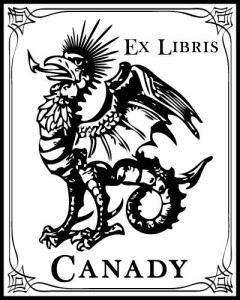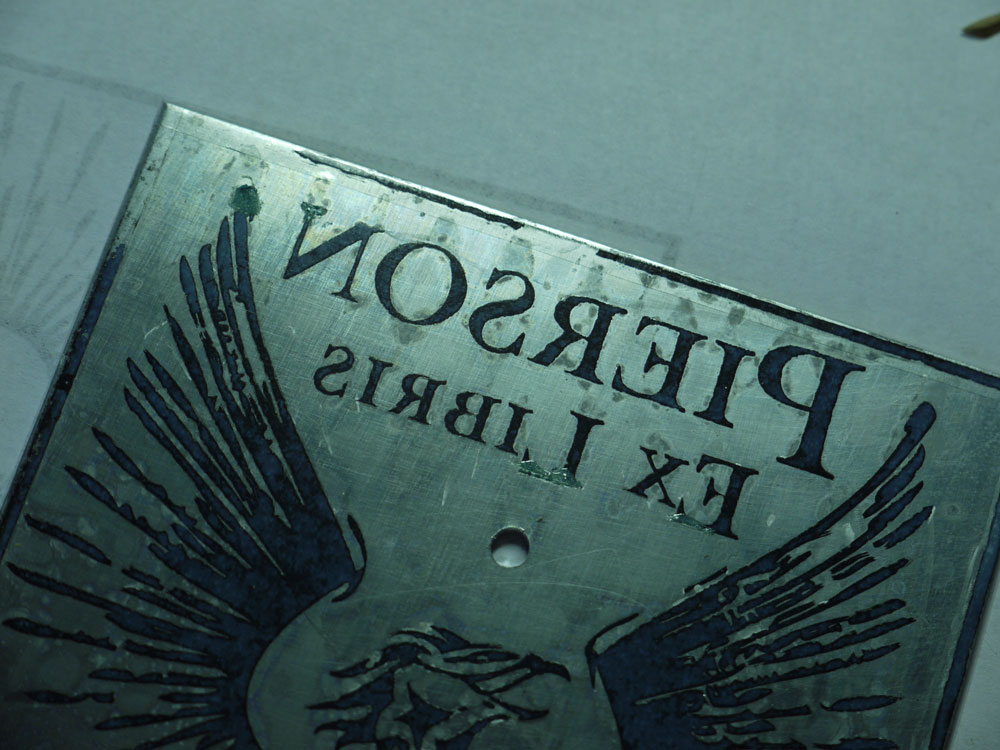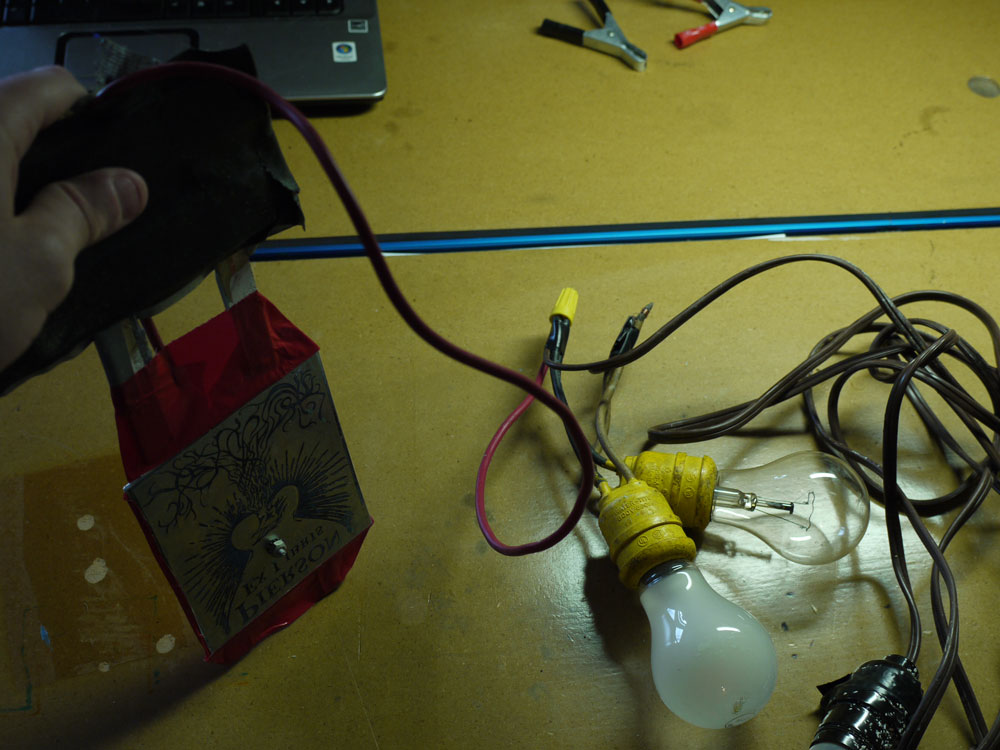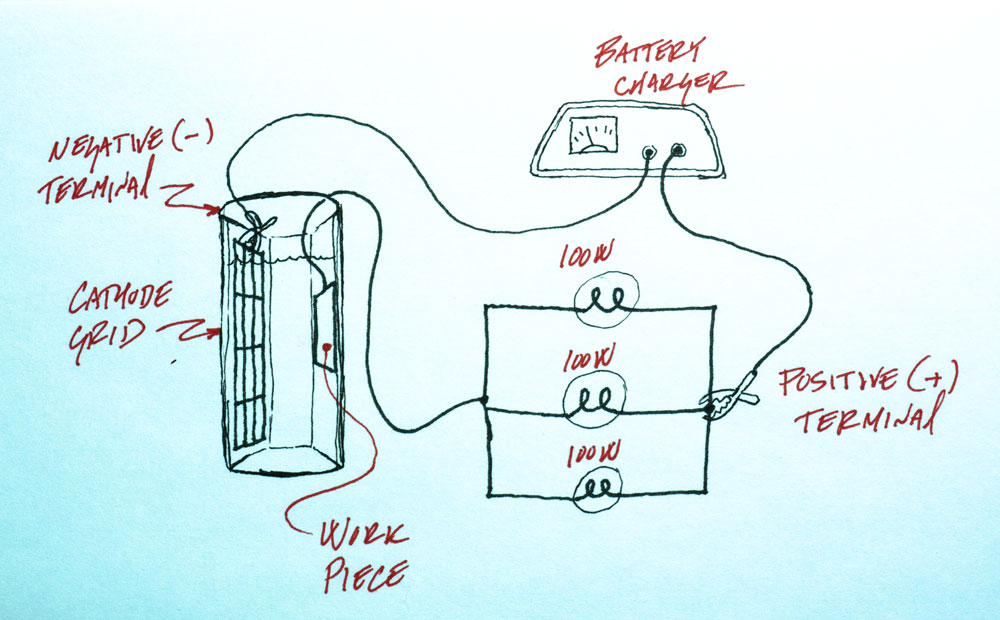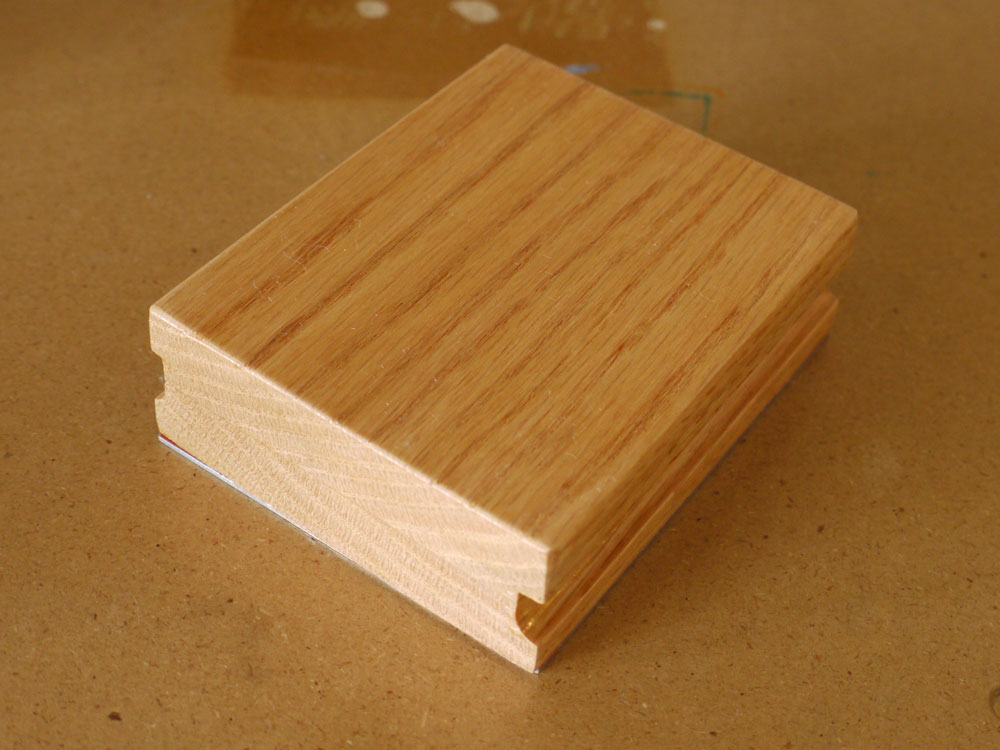Chemicals and Electricity, What Fun! One Christmas, I made custom bookplates for myself and a few friends by etching zinc plates. They came out great, and the process, while taking much longer than I would have liked, is a great technique for customizing copper, brass, or zinc metalwork. Here’s the artwork I did for the whole set:
You Will Need:
- 12ga. zinc plates, available from any well-stocked art supply store. You can also use copper or brass. I’ve read that steel will also etch with this setup, but also that it won’t, so if you have a definitive answer on that let me know.
- Transfer paper. Don’t mess around, use dedicated PCB transfer paper from Pulsar or similar. Their sealing foil further improves the results.
- A clothes iron.
- A plastic water pitcher
- A steel oven rack or barbecue grill
- A few 100W bulbs and sockets
- Pure copper sulfate, which is sold under the trade name RootKill or as Bordeaux mixture. You can find it in the gardening section at Home Despot.
The process of getting all of these from Illustrator into Zinc is somewhat involved, and here I should probably say we will be working with toxic chemicals and electricity, together, and this process releases hydrogen gas, which is highly flammable. It’s not for the faint of heart. But it doesn’t require any special equipment, and if you work safely you should be okay.
Applying the Resist: First, we need to find a way to mask off the parts of the plate we don’t want etched. There are a number of commercial etching resists available, but I used a process which may be familiar to you if you’ve ever etched your own circuit boards, the toner transfer method.
Buy some inexpensive inkjet semi-gloss photo paper, the thinner the paper the better, because it will transfer more heat. Print out your artwork on that paper using a laserjet printer. See, laserjet toner is a type of plastic that is melted onto the paper using, improbably, a laser. We live in the Future, and everything’s amazing, and no one’s happy. Anyway, by using a glossy inkjet paper, the toner won’t stick to the paper very well, and when we put a hot iron on the back of the paper, it will re-melt the toner onto the plate.
[Update: instead of paper, use the purpose-made PCB transfer paper from Pulsar. I’ve had *much* better results than I ever had with inkjet paper, but the process is the same. Also use the green sealing foil.]
Prepare the Plate: clean the oxidation off the plate with steel wool. This will also roughen the plate, making it easier for the toner to stick to it. Next, tape the artwork to the plate. It’s best to tape in a thin 1/8″ strip around the edges, because the tape will interfere with the heat transfer. Once you start ironing and the paper is stuck down to the plate pretty well, you can peel the tape back.
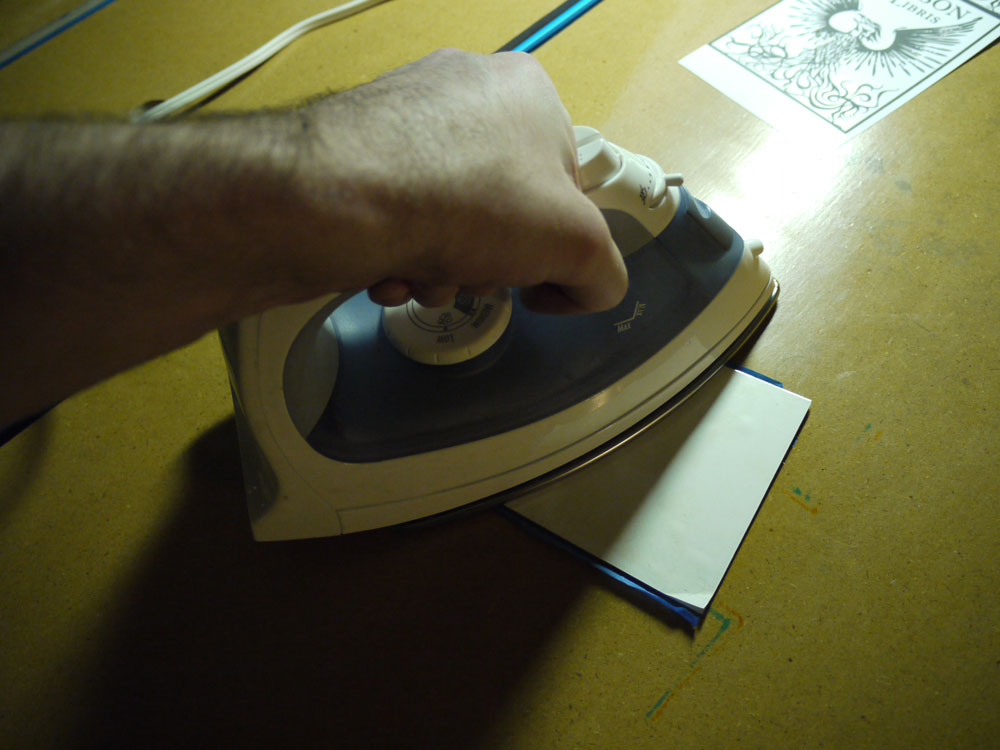
Transfer your Artwork: Set your iron as hot as it will go, with no steam. Work systematically over every part of the plate, moving the iron slowly and using lots of pressure. When you’re done, turn the steam up on high and iron a rag to clean the crap off the iron. Unless you want to ruin the a dress shirt when you next use the iron, three months later, like me. When you’re done, toss the plate and paper into a tub of warm water, and leave it overnight. Don’t try to skip this step; you’ll only pull off half your toner with the paper.
By the way, in the picture above, you can see what ironing on the artwork did to my workbench. This process will destroy the finish on whatever surface you do it on, but if you put a piece of paper in between the plate and the table, you won’t bend the plate because you were prying it up from the tabletop.
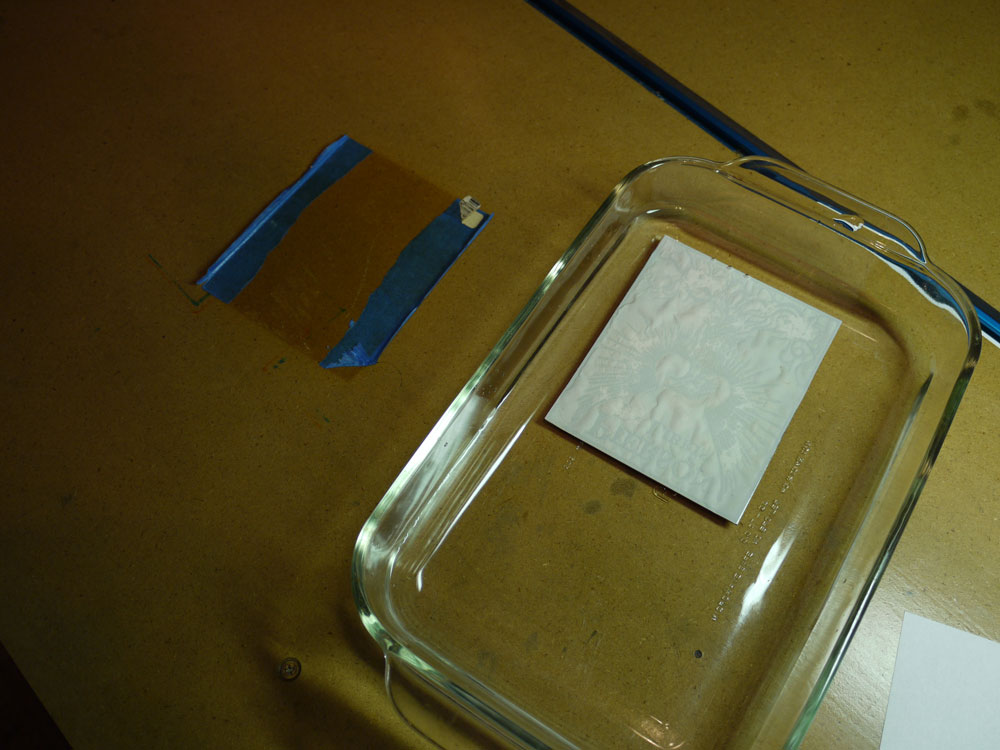 Once the paper has softened in the water, peel off the paper. You’ll find that you can use a scrub pad to get all the pulp off, without removing the toner, as long as you’re gentle. When you’re done, you can fix up any places where the toner didn’t transfer by putting on a dab of paint, then cutting away the parts you don’t want with an X-acto knife.
Once the paper has softened in the water, peel off the paper. You’ll find that you can use a scrub pad to get all the pulp off, without removing the toner, as long as you’re gentle. When you’re done, you can fix up any places where the toner didn’t transfer by putting on a dab of paint, then cutting away the parts you don’t want with an X-acto knife.
The hole is so that you can bolt a wire to the plate. You could solder the wire to the back of the plate, but I didn’t have too much luck with this approach and I didn’t go want to go too hot, for fear of melting the toner off.
The Etching Tank. You want a way to attach your work piece to the positive lead of your battery charger, and suspend it in a bath, parallel to a grid of metal to which you attach your negative lead. You want to do all this securely, because if the positively and negatively charged parts are allowed to touch, you’ll have a short circuit with the usual hazards to life and limb. Here’s my setup:
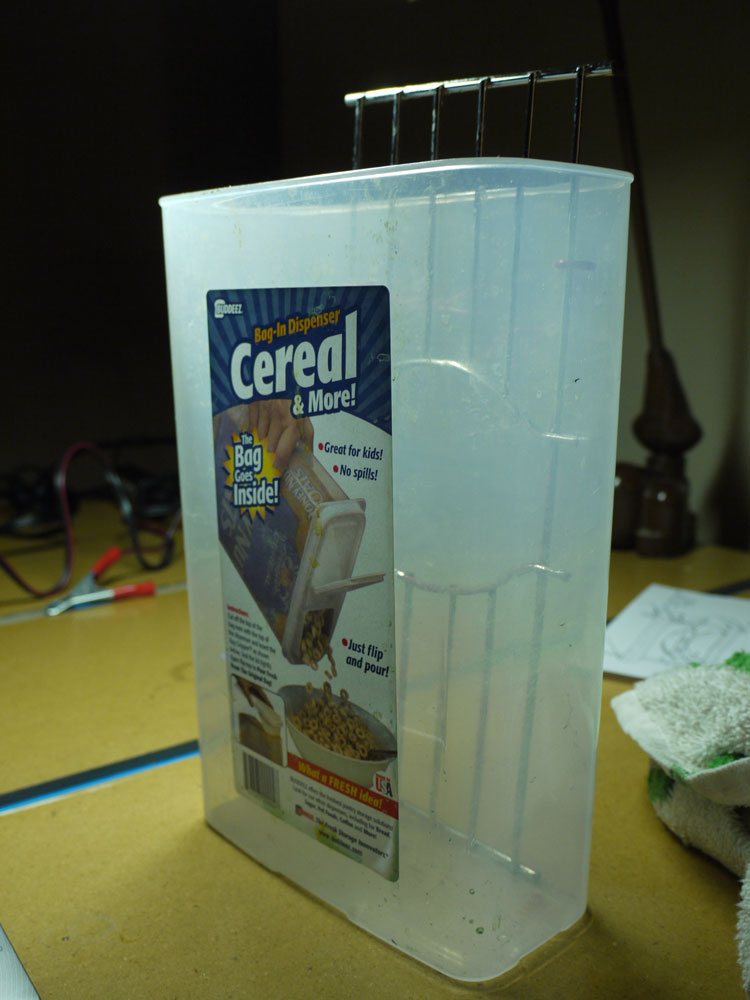
I bought a cheap plastic pitcher and a grill for a barbecue pit. I cut the grill down to size and attached it to the sides of the tank with some wire. I made a frame to attach the work plate to by gluing together some paint stir sticks. I’m always out of paint stir sticks, because they’re so damned useful for so many things unrelated to stirring paint. You know how people bring a bottle of wine when they come over? I have wine, bring paint sticks. Here’s the frame to hold the plate. The tape will hold up in the bath, if you use duct tape instead of gaff tape.
See the bulbs and sockets attached to the wire? That brings us to the next part,
The Electrical Circuit: You’ll attach the negative terminal of the battery charger to the barbecue grid (cathode), and the positive terminal to the work plate, according to the following diagram:
In between the two terminals, you’ll probably want some additional resistance. The reasons for this are twofold. First, if you do accidentally touch the two parts together, you’ll have some load in the circuit, rather than just a dead short. Secondly, the resistance of the circuit will probably be too low without them. If the bath looks like it’s boiling when you connect up the leads, you definitely need some additional load. In my setup, I have three 100W lamps in parallel in the circuit. Recalling that:
Wattage = Voltage * Current
The resulting current through each 100W bulb is:
Current = 100W / 120V = .833A
Since:
Voltage = Current * Resistance
The resulting resistance of each bulb is:
Resistance = 120V / .833A = 144Ω
Recalling that parallel resistance is governed by the equation:

The resulting resistance is:
Req = 1 /( 3/144Ω) = 48Ω
At that resistance and 12V, the resulting current would be .25A, or 3W, so if you wanted to use a 5W, 50Ω resistor, or better yet two 5W, 100Ω resistors in parallel, that would work fine.
The Etching Process: add a small amount of copper sulfate into the water, stir, then wait a few minutes. Keep this up until no more crystals will dissolve in the water. As the plate etches, it’ll get covered with dark crud. Pull the plate out of the bath every fifteen minutes and clean it off with a soft brush.
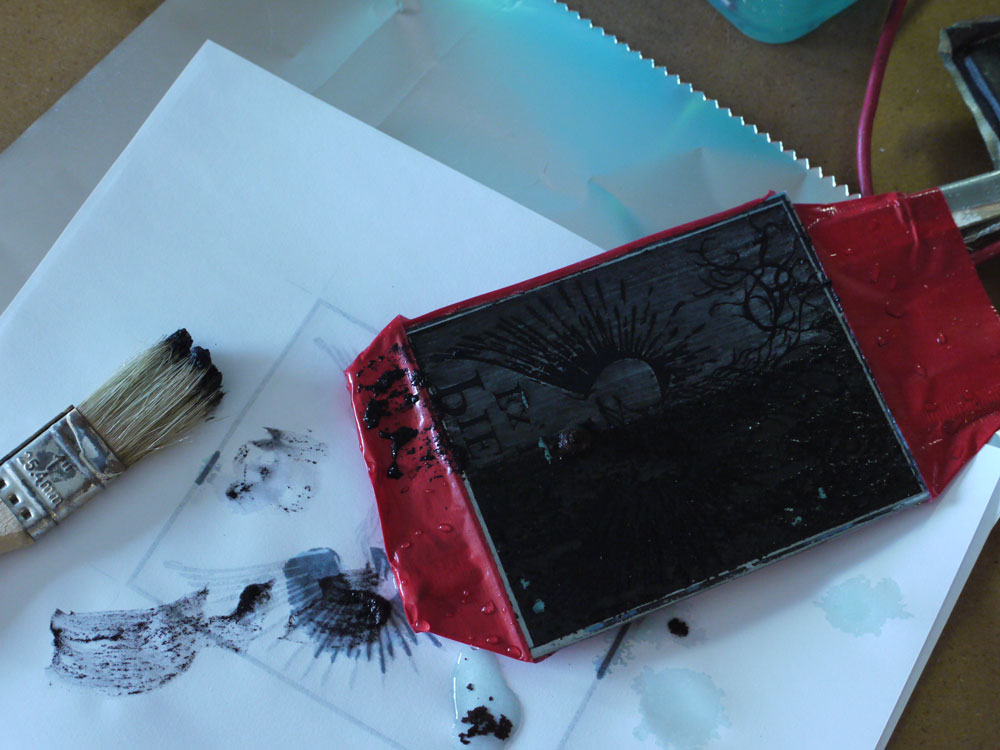 You don’t have to go all that deep to get a good print, 1/32″ is plenty. When you’re done, rinse off the plate and take off the toner with steel wool. Your finished plate will look like this:
You don’t have to go all that deep to get a good print, 1/32″ is plenty. When you’re done, rinse off the plate and take off the toner with steel wool. Your finished plate will look like this:
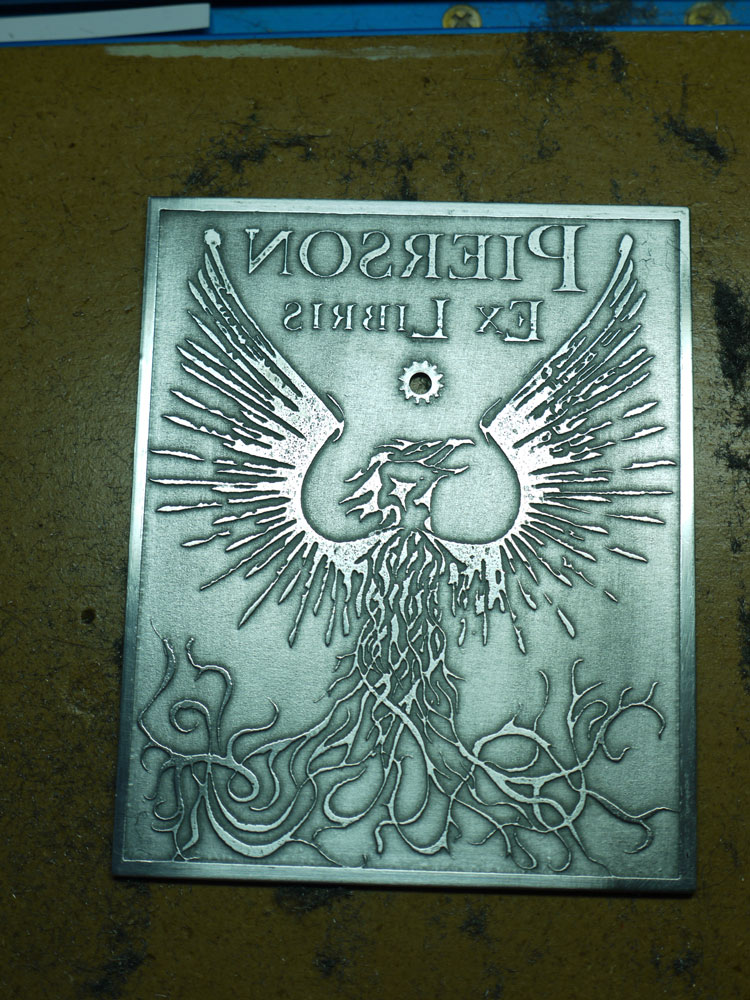 If you’re using a stamp pad, you may want to put a coat of clear enamel on the plate, which will hold the ink better. If you’re using the thicker block printing ink, this is not a worry.
If you’re using a stamp pad, you may want to put a coat of clear enamel on the plate, which will hold the ink better. If you’re using the thicker block printing ink, this is not a worry.
Also, if you put a wood backing onto the back of the plate, it will prevent the plate from flexing, so you won’t get a print in large open areas. I made mine out of a 4″x3/4″ plank of oak, which I doubled up and cut the handhold on the side with a router. It came out nicely:
Disposal: the amount of dissolved copper solution produced isn’t really enough to be a serious environmental worry, but cleanup is easy. Toss a piece of steel wool in the tank overnight and the copper in the solution will immersion plate onto the steel. If you carefully lift the steel wool out of the solution, you should be able to remove most of the copper from the solution. You can then throw the steel wool and plated copper away (or recycle it, I suppose), it’s not a hazard in solid form.
Further Reading:
- Cedric Green’s excellent site on various etching techniques and their relative advantages, with an emphasis on the galvanic technique used here:https://www.greenart.info/galvetch/contfram.htm
- Jake Von Slatt’s walkthrough of electrolytic etching of brass, using the same technique used here:https://steampunkworkshop.com/electroetch.shtml
Good luck, let me know how you make out!
